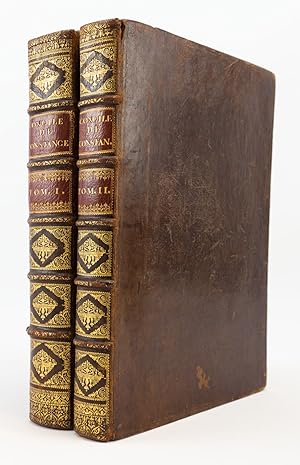Beschreibung
290 x 220 mm. (11 1/2 x 8 3/4"). Two volumes. Excellent contemporary calf, raised bands, spine lavishly gilt in compartments with unusual architectural centerpiece, intricate scrolling cornerpieces with lancet accents, two red morocco labels, marbled endpapers. Title pages with engraved vignette of the council, dedication page with engraved royal arms of Frederick William of Prussia, decorative engraved initials, and 19 ENGRAVED PORTRAITS BY BERNARD PICART. A Large Paper Copy. Front pastedowns with private library shelf label of Bessinge. Title pages of both volumes with signature of Charles Richard Tronchin. Brunet III, 976. â Volume II with half-inch split at head of front joint and small patch of lost patina (from insect activity) on front board, joints and extremities of both volumes a little rubbed, boards with light chafing or faint scratches, isolated mild browning or other trivial imperfections but still AN EXTREMELY APPEALING SET--entirely clean and fresh internally with especially ample margins, with sharp impressions of unusually bright plates, and with bindings showing no significant signs of use and looking very attractive on the shelf. This is a handsomely illustrated history of the Council of Constance, the 15th century ecumenical council that resolved the Western Schism, elected a new pope for the unified Roman Catholic Church, and condemned reformer Jan Hus as a heretic. It is enlivened with beautiful portraits of the participants by an artist Ray considers "the outstanding professional illustrator of the first third of the eighteenth century." Our author, French Protestant divine Jacques Lenfant (1661-1728), drew heavily on writings by those present at the council for this account, which is considered a fair recording of the proceedings. Lenfant likely felt some sympathy for Hus, tried and burned at the stake for heresy, and for his countryman Jerome of Prague, who came to support Hus and ended up meeting the same fate. Picart has referenced their martyrdom in his portraits, depicting Hus' execution in a vignette beneath his portrait, and balancing the tondo portrait of Jerome on a pile of burning logs. Similarly, the radical English theologian John Wycliffe, posthumously convicted of heresy at the council, is pictured over a stack of burning books, his writing having been condemned to this fate. But in addition to the harsh reality of burning execution, Picart employs gentler details: Parisian Jean Gerson, the formidable Chancellor of Paris, is in sober robes, but the adorable fluffy puppy beneath his portrait softens his image considerably. The cardinal of Foix, who had negotiated the end of the schism involving rival popes in Rome and Avignon, is flanked by a cherub holding an olive branch, looking askance at a slain dragon which has been relieved of his many heads. The new pope, Martin V, is shown with the insignia of the papacy and a dove clasping an olive branch in its beak. The portrait of Italian humanist Poggio Bracciolini is shown hanging in an open window that looks out on his city of Florence, with a stack of books by Quintilian and other classical authors Poggio had rescued from obscurity on the windowsill. Throughout, Picart's facial images are strikingly individuated--these are convincing portraits that project history from the book's pages. Picart (1673-1733) was born in Paris, where he learned engraving from his father, Etienne, and from Sébastian Le Clerc, and "early acquired a reputation both as an artist and engraver." He moved to the busy publishing city of Amsterdam sometime before 1712, and established himself as both printseller and illustrator/engraver. There, he designed and engraved an impressive body of illustrations for Dutch printers at a time when, in Ray's words, "designs for the finest illustrated books were typically drawn by leading painters." Our previous owner Charles Richard Tronchin (1763-1835), was a Swiss politician of great wealth who donate very substantial sums to.
Bestandsnummer des Verkäufers ST19517b
Verkäufer kontaktieren
Diesen Artikel melden




